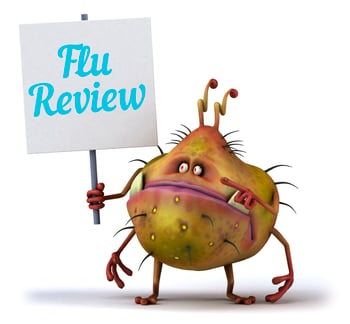Are we there yet? According to the Centers for Disease Control and Prevention, we are just about to the end of the 2014-15 flu season!
We all know that this flu season was an interesting one. With the circulating strains a bit different from that in the virus, we saw a pretty active flu season. Check out the major takeaways from this past flu season.
 The Vaccine
The Vaccine
As you hopefully have heard by now, the flu vaccine is made from a deactivated version of the flu. Early each year, experts predict the strains of flu virus that will circulate that fall. They must make their predictions early so manufacturers can have enough flu vaccine made to go around. The problem with the early prediction, however, is that the flu virus can mutate.
That was the case this year. The predominate flu strain was a mismatched H3N2 virus. This means that the H3N2 virus the vaccine covered isn’t what people were contracting, which provided for a lower effectiveness of this year’s vaccine. While there were quite a few more cases of the flu than usual, people who got the vaccine likely had less severe symptoms, even if they contracted the mismatched strain.
Overall, 7 manufacturers reported making 151-156 million doses of the flu vaccine. Of these doses, 76 million were quadrivalent, meaning they protect against four different flu strains. The rest were trivalent, which protect against three different flu strains.
The Numbers
Even though a large number of flu vaccine was made, we unfortunately still have flu virus statistics to report. It’s difficult to gauge the true number of people who suffered from the flu, though, because not everyone seeks treatment. The numbers are usually presented in hospitalizations rather than cases.
The two populations at greatest risk for the flu are the elderly and young children. These populations also usually tend to fare worse in H3N2 predominate flu seasons.
This year, nearly 60% of flu hospitalizations were people over 65 years old. This is the highest number of hospitalizations in this age group since the CDC started recording the numbers in 2005. According to the CDC, 266.1 out of 100,000 population in this age group were hospitalized for the flu.
Children were the next largest population to be hospitalized, but the number was actually less than the last H3N2 predominate season. Of 100,000 population of children, 47.8 were hospitalized for the flu.
The Timing
The definition of flu season relies on these reported cases of the virus. While it is typical to see a flu epidemic every year, flu season can start as early as October and go as late as May. It all depends on when we start to see spikes in the number of cases reported.
This year, we began to see an increase in flu cases in November. The number of cases remained elevated through February, but is expected to continue on a steady decline now that we’re through flu season. The peak of the 2014-15 flu season occurred between December and January (week 52-week1). This is a typical time for the peak that we usually see anywhere from December to February.
Looking Ahead
As we finish off the 2014-15 flu season, it’s important to take what we saw and learn from it for next year. Even though the flu vaccine effectiveness can vary from year to year, it is still the number one way to protect yourself and your employees from the flu. Consider hosting an on-site flu clinic or providing a voucher program to give your employees an easy opportunity to protect themselves. The flu experts have already made their predictions and begun planning the vaccine supply for the 2015-16 flu season, so you should too!
It’s also important to focus on hygiene all year long. Your office can quickly become a incubator for many kinds of germs. Be sure to keep the place clean!
Finally, you’ll need to start planning early. As we learn from every flu season we pass through, the recommendations and supplies change. Make sure you book flu clinics early in the Spring or Summer, get your vaccination done early in Fall and catch any symptoms early if they do strike. Stay ahead of the epidemic and keep yourself healthy during flu season 2015-16.
Each year, flu season is a little bit different. The virus continues to change, so our response does too. Take a look back at how your office handled flu season and brainstorm ways you can do better this fall.
How do you keep your employees safe from the flu?



